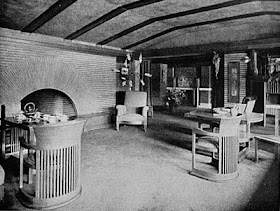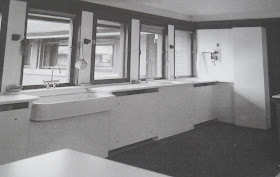My family from Arizona was coming back east for a visit so I drove to Western New York, where I grew up, for a family reunion of sorts. Having grown up in the country about an hour from Buffalo, a trip to the "big city" was often reserved for a special occasion like Christmas shopping. We weren't even aware there was a Frank Lloyd Wright house in Buffalo until about 2007 and this seemed like a special occasion to visit the Darwin Martin house.
When you turn off Buffalo's Main Street onto Jewett Parkway, you immediately notice something is different. The street's gentle curve showcases the mature trees that line the streets. Most the houses are set back from the street leaving a true front yard which seems so unusual in such a densely built urban area.
It turns out that this Parkside area of Buffalo was designed in 1876 by Frederick Law Olmstead, landscape architect behind Central Park and Boston's Emerald Necklace just to name a few. It's a little surreal when the Victorian neighborhood yields to Frank Lloyd Wright's sprawling Darwin Martin House, actually a complex of several Wright-designed structures commissioned by Martin.
The house on the right was first built in 1903 for Darwin Martin's sister. It's now known as the Barton House. The Darwin Martin house is in the right and it's connected to a conservatory and carriage house by a long pergola.
Original stained glass window on the Barton House.
Side of Barton House (right) and terrace of Darwin Martin house (left).
It's hard to believe these were built in 1903, the beginning of the Edwardian era. Think 10 years before Downton Abbey was filmed!
Photo of workers during construction.
The Darwin Martin house is considered an excellent example of Wright's prairie style characterized by strong horizontal lines created by long low spaces, shallow hipped roofs, low chimneys, terraces and cantilevered overhangs. The steel beam construction also allowed for an open concept interior for the first time.
The horizontal lines are supported with long narrow yellow Roman bricks with recessed mortar in the horizontal joints.
To minimize vertical lines, Wright used drains to catch water from the gutters without using a downspout.
View from Martin house across the street.
Front entrance of the Martin house.
From the rear of the Martin house, the pergola extends back to the conservatory (under the pagoda) and the carriage house on the left.
Exterior of conservatory.
While it seems amazing that all these structures remain intact, it's not really the case. Darwin Martin retired a millionaire but lost his entire fortune during the depression. After his death in 1935, his wife was unable to maintain the house and she abandoned it in 1937. The house remained vacant until 1954.
 |
| Darwin Martin House circa 1965. Photo: Wikipedia. |
In 1962, the pergola, conservatory and carriage house were demolished to make room for four apartment buildings.
I did an extensive search on the internet to find photos of the complex during that time but could only find one photo of the apartment buildings being demolished.
The pergola and carriage house were rebuilt in 2007 and the entire complex in undergoing a $50 million renovation. Photos are not allowed inside the house but I've assembled several old photos I found online of the home's interiors.
The receiving room. All of the furniture was designed by Wright and about 80 percent of the original furniture was saved by Martin's son and has placed back at the house.
The receiving room today.
The living room.
The living room fireplace.
The Martin and Barton children in the garden, 1907.
The dining room.
All the interior spaces are all quite open. Each of the spaces are defined by sets of brick piers into which bookcases are built.
The kitchen has a very different feel than the rest of the house. It was done at a time that people were learning about germs so the kitchen is white and pristine so dirt could be seen. It is presently undergoing restoration but the original sink is still in place.
View from the foyer down the pergola into the conservatory.
A replica of the Winged Victory of Samothrace sits at the far end of the conservatory.
 |
| Photo: Prairie School Traveler |
The conservatory today.
The Barton house was privately owned until 1994 when it was purchased by a benefactor and donated to the complex. I understand the price was about $500,000.
The Wright-designed gardener's cottage was also privately owned until 2006 when it was purchased and became part of the complex.
All the buildings in the complex are now open to the public for tours. If you're ever in the Buffalo area, you should make it a point to visit. More information can be found
here.

























































